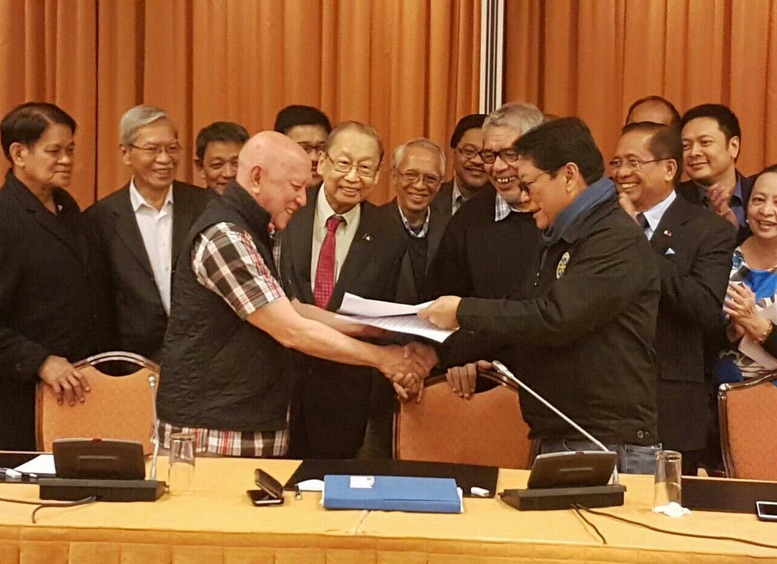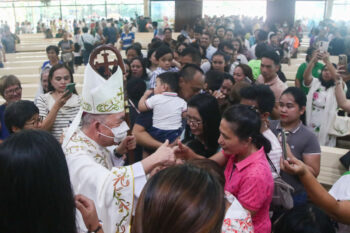DAVAO CITY (MindaNews/ 05 April) — The Philippine government (GRP) and the National Democratic Front (NDF) signed Wednesday an interim joint ceasefire agreement which will take effect upon the approval and signing of guidelines and ground rules.
“Just signed interim joint ceasefire but effective only when we approve the guidelines and mechanisms,” Jesus Dureza, Presidential Adviser on the Peace Process told MindaNews in a text message from Noordwijk aan Zee, The Netherlands, venue of the fourth round of formal peace talks.
 SIGNED. Government peace panel chair SIlvestre Bello III (r) and NDF peace panel chair FIdel Agcaoili exchange copies of the signed Interim Joint Ceasefire Agreement Wednesday in The Netherlands. Photo courtesy of OPAPP
SIGNED. Government peace panel chair SIlvestre Bello III (r) and NDF peace panel chair FIdel Agcaoili exchange copies of the signed Interim Joint Ceasefire Agreement Wednesday in The Netherlands. Photo courtesy of OPAPP
Asked when the guidelines will be approved, Dureza replied, “meetings will be held in between formal talks so anytime when ceasefire committees go back home.”
The Agreement on an Interim Joint Ceasefire provides that it will be effective “until a permanent ceasefire agreement is forged as part of the Comprehensive Agreement on End of Hostilities and Disposition of Forces” or the Final Peace Agreement.
“Relieved,” government peace panel chair Silvestre Bello III said of how he felt that the interim joint ceasefire was signed.
At the opening of the talks on April 3, NDF chief political consultant Jose Ma. Sison and NDF peace panel chair Fidel Agcaoili said they want the Comprehensive Agreement on Social and Economic Reforms (CASER) signed first before a joint ceasefire agreement is forged, or both can be signed simultaneously.
NDF peace panel chair Fidel Agcaoili reiterated “the wisdom of securing the approval of the CASER ahead of any bilateral ceasefire agreement, unless both agreements can be signed simultaneously.”
Guidelines and ground rules
The parties agreed to direct their ceasefire committees to “meet even in between formal talks, to discuss, formulate, and finalize the guidelines and ground rules” for the implementation of the agreement.
The fifth round of formal peace talks is scheduled on May 27 to June 2 in The Netherlands, Bello told MindaNews.
The ceasefire committees of both parties will include in the guidelines rules governing the presence of armed units and elements of both parties in local communities and the creation of buffer zones; an agreement on what are considered as prohibited, hostile, and provocative acts; and ceasefire monitoring and verification mechanisms in relation to the implementation of the ceasefire and the handling of complaints and alleged violations.
The GRP and NDF also agreed that “matters regarding a single governmental authority and taxation shall be discussed and resolved in forging of the Comprehensive Agreement on Political and Constitutional Reforms within the framework of the proposed Federal Republic of the Philippines.”
The parties said the objectives of the joint ceasefire are to generate goodwill and trust in the GRP-NDF peace negotiations; encourage the forging of a more stable and comprehensive Joint Ceasefire Agreement, and provide an enabling environment for eventual and early signing of the CASER.
The interim joint ceasefire agreement was signed by GRP peace panel chair Bello and panel members Hernani Braganza, Rene Sarmiento, Antonio Arellano, and Angela Librado-Trinidad.
NDF peace panel chair Agcaoili signed for the NDF, along with panel members Benito Tiamzon, Coni Ledesma, Julieta de Lima, and Asterio Palima.
Signing as witnesses are Dureza, and NDF chief political consultant Jose Maria Sison, and peace panel advisers Mayor Edgardo Pamintuan for the government and Luis Jalandoni for the NDF and third party facilitator Elisabeth Slattum for the Royal Norwegian Govenrment.
Bilateral ceasefire
The government and NDF each declared a unilateral ceasefire before the first round of formal peace talks in August last year, at the end of which they agreed that their unilateral ceasefire declarations will continue indefinitely as their ceasefire committees “reconcile and develop their separate unilateral ceasefire orders into a single unified bilateral agreement within 60 days” from August 26.
No bilateral ceasefire was forged at the end of 60 days. The “indefinite” unilateral ceasefire, was lifted in February.
The proposed bilateral ceasefire is a major breakthrough in the three decades of peace negotiations across six Presidential administrations — Corazon Aquino, Fidel Ramos, Joseph Estrada, Gloria Macapagal-Arroyo, Benigno Simeon Aquino and the President Rodrigo Duterte — as it will only be the second since 1986.
The last bilateral ceasefire was signed in November 1986, to cover a 60-day period starting December 10, 1986 but was not renewed following alleged violations by the military, as well as the massacre of protesting farmers in Mendiola in January 1987. The NDF issued a statement on February 8, 1987 declaring it “cannot see any justification for extending.”
Both parties traded accusations of violating the ceasefire. (Carolyn O. Arguillas / MindaNews)
